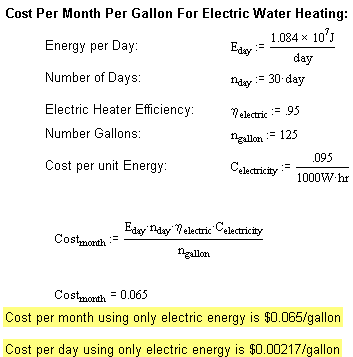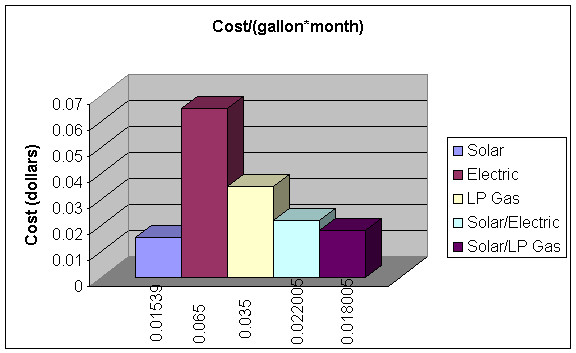
Supplementary
Heating
Cloud cover affects the dependability of the solar heating system more than any other single element. Even extremely cold ambient conditions do not prevent the solar collector from gathering more than enough radiated energy to maintain the aquaculture tank indefinitely. However, given a sufficiently cloudy day, the solar collector begins to act as a black body radiator emitting energy to a gray sky.
While simply suspending solar collection will stop the wasting of stored energy, several cloudy days in a row can exhaust the built up reserves. Empirical evidence suggests that given an equal amount of energy storage water and aquaculture water, the test system can store enough energy for 2-3/4 days (with no margin of safety). However, prudence suggests that at the 48-hour mark, supplementary heating will be required.
There are two types of supplementary heating systems that were investigated. These were:
∑ Commercial Grade Electric Water Heaters
∑ Commercial Grade LP Heating Systems
Due to the particular system needs in each aquaculture project, very specific conclusions as to heating system costs or needs selection are difficult to come to. However, general costs are easily assimilated and compared. For the purpose of this discussion, heat loss rates per gallon will be used to make the small trial systemís empirical data relate better to a large-scale commercial system.
Testing concluded that 86.7 kJ/gal are required daily to maintain the system. This empirical data can be applied to larger systems by merely multiplying the cost per gallon by the number of gallons of water being heated. To derive a value for comparison, the amount of energy required to maintain the water was multiplied by both typical electric and gas heater efficiencies and energy source cost to come up with a comparable cost per gallon estimate.
The cost for electric heating was found by using the following relationship:

The cost for electric heating was found by using the following relationship:

The set-up costs for gas and electric systems are comparable, while the solar collection set-up is more costly but has a minimal maintenance and operation cost, namely just electricity to run the circulation pump. In the long term, the operating costs of the gas and electric systems will dwarf the initial construction cost while the solar system incurs almost no addition costs over those sustained at the time of the primary set-up.
Since the solar collection array is not 100% reliable, the best system will be a hybrid that uses solar radiation as the primary source for heating, and falls back on more conventional methods during long periods of inclement (overcast/rainy) weather. The figure below shows both straight and hybrid costs in dollars per month per gallon:

As the bar graph shows, the cost of solar heating is minimal when compared to the other methods. Prices were derived from locally available sources, with LP gas costing $1.98 per gallon and carrying a heating value of approximately 91,650 BTU per gallon. Electricity in the Talquin Co-Op is sold at around 8.5 cents per kW*hr, and is very inexpensive. Other power companies in Florida sell electricity for as much as 13 cents per kW*hr, which would push the electric operating cost up about 50%
As can be seen, the low cost of solar power and the low frequency of use of the backup system serves to even up overall monthly costs between LP and electric methods. Ultimately, a decision based on local LP availability and electric prices must be made for each application.